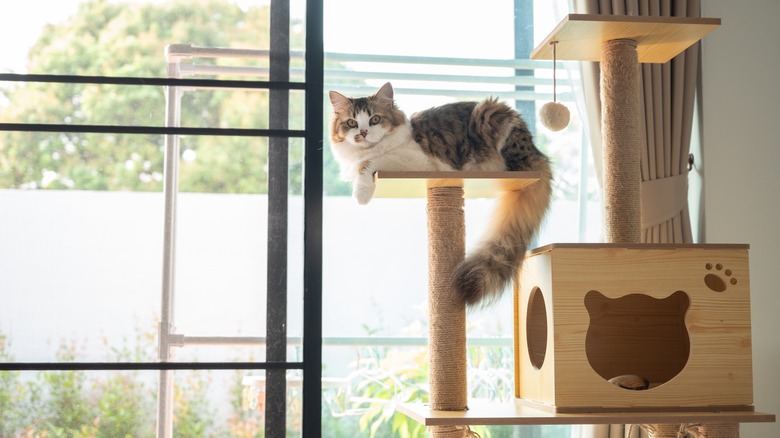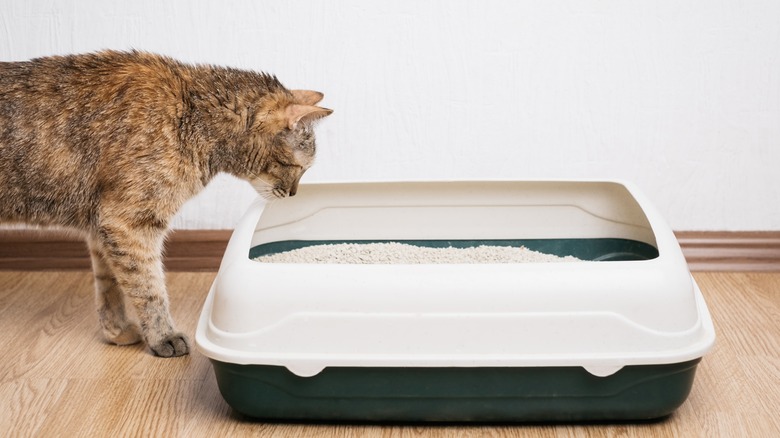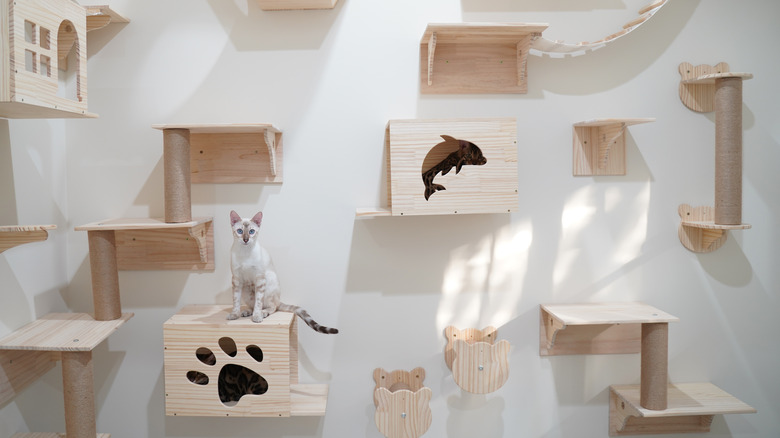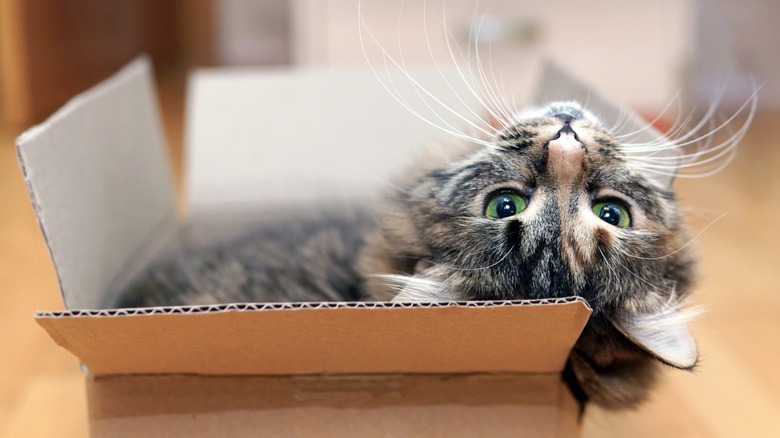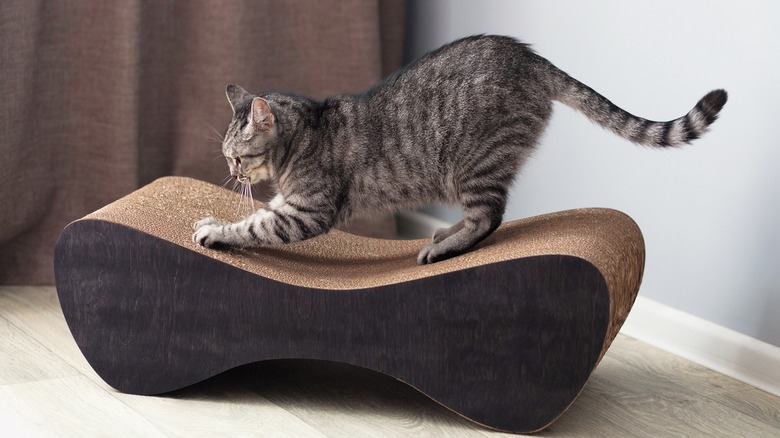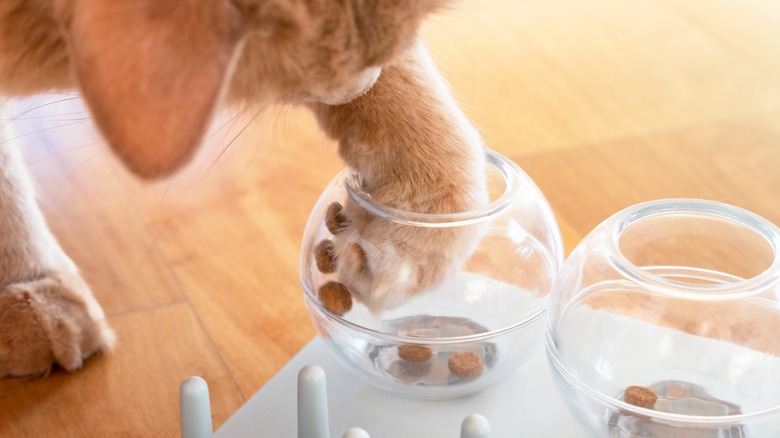How To Catify A Small Apartment, According To An Expert
Why do cats do what they do? Whether climbing to the highest point in the room or purposefully antagonizing the dog, they are quite confounding creatures. Scientists don't have a lot of research to work from to best understand these animals, as noted by Penn Today – but they do know that their ancestors were solitary creatures, preferring to be alone rather than with other animals. Today's cat is more tolerant of being around both other kitties and people. Yet, they arguably are still not socially adapted the way dogs often are. That and the fact that they can be very curious makes it critical to understand your animal's personality and behaviors, especially if you want to co-exist in a meaningful way.
Though they say these feline family members have nine lives, ensuring your apartment is safe for your cat is a must to avoid expensive repairs and vet bills. You also want to make sure it's furnished and customized so that they can feel both accommodated and stimulating. To that end, Dr. Paola Cuevas, a veterinarian, MVZ, and behaviorist with Excited Cats, shares strategies for catifying a small apartment in an exclusive interview with House Digest. It's a great way to build a better relationship with your feline companion or ready your home to introduce one.
Select the right litter box
First and foremost, Dr. Paola Cuevas points out one of the advantages of having cats as pets: their restroom habits. "Most cats will learn to use litter boxes quite easily, though finding the right litter can be a challenge for some," she explains. However, since many apartments don't have a lot of room for the litter box to be in a separate area, that may tempt you to put it in the laundry room or by the furnace just to get it out of the way — but that may not be the best idea. "Litter boxes should be placed in a quiet area and away from traffic or noisy machines," Dr. Cuevas continues." So instead, try finding a cozy corner in a more secluded area.
Many cat guardians tend to put litter boxes in certain areas, too. "In apartments, litter boxes are usually kept in the toilet room," Dr. Cuevas adds. "Speaking about toilets, you might need to get into the habit of having to put down the toilet seat cover to avoid your cat drinking from it." That's not a habit you want to encourage; even if they just want to splash in the water or lap at it, you don't want that behavior to occur.
Give your cat places to climb
Cats are often noted for their adept climbing abilities; they are sure to test out what they can do to reach the highest perch possible in the home. Dr. Paola Cuevas agrees that this is very common, too. "Climbing is a natural behavior for cats, who love to observe their environment from higher up," she reveals. "In fact, cats that are dominant over others get to enjoy the highest resting spots available."
Since they are going to climb anyway — even on your kitchen counters if you don't train them not to – it's best that you do what you can to make sure they can do so without incident. Fortunately, Dr. Cuevas offers some insight on this. "Provide your cat with safe climbing opportunities, and make sure your shelves are clear of any small or breakable object," she continues. "Apartment cats should at the very least have a cat tree, but there are plenty of great ways to use the vertical space of the walls. With imagination and basic materials, there are some great ideas and DIY project inspirations to help provide your cat with the perfect vertical climbing space." Certainly, get creative, but be sure to know any limitations based on your rental agreement, too.
Make sure you have hiding spaces
Even in small apartments it's essential to create spaces in which your kitty can feel safe and protected, per Dr. Paola Cuevas. "Hiding is also a cat's natural behavior. They love to hang out in spots where they can check out the environment without being seen," she reveals. "They are predators, after all. Hiding space also provides your cat with a sense of security and well-being that is very important for their mental health."
Creating hiding spaces could seem like a challenge, especially if you have an open-concept home or you just don't have a lot of space. Fortunately, Dr. Cuevas has some tips on how to provide this necessity for your feline friend. "You really do not need to invest a lot of money on this one since most cats love cardboard boxes," she adds. "But again, pretty looking cat castles or DIY projects could make your apartment look great." So depending on your resources and your furry one's needs, work together to figure out the best arrangement.
Provide cats with items to scratch
Though creating an ideal environment for your feline is often done to help ensure that they are happy and satisfied, taking the right steps can also minimize the risks to your home. To that end, Dr. Paola Cuevas offers a word of caution. "If you do not provide your cat with a designated scratcher, it will go after your furniture," she points out. In other words, your beautiful leather sofa could quite quickly become full of nail marks and long scratches if you don't provide your kitty with the resources they need and deserve.
You may wonder, though: Why are cats prone to such actions? "Scratching is a natural behavior that helps them keep their claws in shape and stretch their bodies," Dr. Cuevas continues. "For the sake of your furniture, get a scratching post even before the cat." You can create your own using cardboard boxes or invest in a few carpet remnants that you staple to a piece of wood.
Provide areas for mental stimulation
A small apartment may not offer a lot of opportunities for cats to engage socially or explore the outdoors, especially if you don't have a screened-in patio or ample vertical space. However, that's fine if you make sure there's enough for them to occupy their time — and natural instincts. "Mental stimulation is very important to avoid behavior issues such as anxiety and aggression and prevent destructive behaviors," Dr. Paola Cuevas explains. "Toys such as puzzle feeders or a cat hammock by the window can help to keep your cat entertained and engaged."
It's easy enough to find some great toys online or in a local pet shop that may be inexpensive and quite engaging, too. "Private a variety of toys and do not forget to constantly rotate between them to keep them novel and prevent boredom," Dr. Cuevas concludes. "Sensorial stimulation can be achieved by adding a small cat-friendly plant garden with catnip, cat thyme, valerian root, and cat grass to your balcony."
